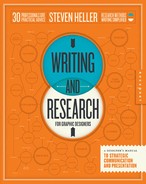(Ray)
(Fogra 29_WF)Job:08-28858 Title:RP-Writing & Research for Graphic Designers
#175 Dtp:225 Page:30
018-055_28858.indd 30 8/30/12 4:42 PM
(Ray)
(Fogra 29_WF)Job:08-28858 Title:RP-Writing & Research for Graphic Designers
#175 Dtp:225 Page:31
018-055_28858.indd 31 8/30/12 4:42 PM
(Text)
READING
VOICE
EDIT STRATEGY TARGET
IDEAS
(Ray)
(Fogra 29_WF)Job:08-28858 Title:RP-Writing & Research for Graphic Designers
#175 Dtp:225 Page:30
018-055_28858.indd 30 8/30/12 4:35 PM
(Text)
Getting your ideas across is a big job. Taking your
thoughts and translating them into written language
is not to be taken lightly. This section will provide
the tools you might need. But first, get in the mood.
Where you write is as important as how you write. What is the most comfortable place to be? For me
it is in a comfy office chair in front of a large screen; if it is less than 33 inches (84 cm) I feel constricted.
So find your comfort zone—whether it’s a desk with writing paper, a lap with your Mac Air, a table with
a large keyboard, or even one of those things . . . what is it called? Oh yes, a typewriter. Make sure you
are away from distractions too. No phones. No open web pages or apps. That being said, everyone has
rituals. Figure out what yours are and get them out of the way.
When I start a new essay or article, I have to walk around the room a bit before I achieve my first
paragraph. Then I have to release all the clichés I know on the page or screen. Once they are written
and then edited out, I’m ready to start. That’s when I being to really exercise my voice.
Your Voice
There is writing and then there is WRITING. Almost anyone can write a note or letter. Putting words
together that result in a comprehensible sentence is not terribly difficult once you acquire the knack.
Making those sentences fit neatly into a paragraph, however, is exponentially harder. Then from one
paragraph to a string of contiguous paragraphs that tell a story or convey a layered message, now that
is difficult. That is what many call writing.
What I call fundamental writing is in all lowercase in the previous paragraph, because it is by no
means extraordinary that a designer can successfully master this skill. Even if visual literacy is your
forte, verbal literacy—and that means transcription of thoughts and ideas through words—is essential
to being a designer. You have to know how to read and write to graduate from any school, including the
design academy.
On a scale of one to ten, just being proficient at lowercase writing is a five. This means you can write
a common letter, convey instructions, maybe even pen a proposal or brief for a particular design. To rise
above that baseline, however, you must also have a voice. By voice, I mean personality. And by personality,
I mean a quality of putting words, sentences, paragraphs, and thoughts together that are noticeably your
own—some method or manner that distinguishes what you have to say, and how you say it, from standard
or proper usage. This can be accomplished in any number of ways.
writing
Thoughts on Paper or Screen
(Ray)
(Fogra 29_WF)Job:08-28858 Title:RP-Writing & Research for Graphic Designers
#175 Dtp:225 Page:31
018-055_28858.indd 31 8/30/12 4:35 PM
..................Content has been hidden....................
You can't read the all page of ebook, please click here login for view all page.
